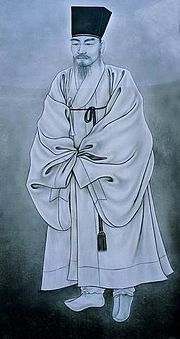Jo Gwang-jo
| Korean spelling | |
|---|---|
| Hangeul | 조광조 |
| Hanja | 趙光祖 |
|
Revised Romanization |
Jo Gwang-jo |
|
McCune- Reischauer |
Cho Kwangjo |
Jo Gwang-jo (* 1482 ; † 1519 ) was a Korean politician and Neo-Confucian philosopher who carried out radical reforms in the early 16th century under the reign of King Jungjong of the Joseon Dynasty . The part of his name, Gwang-jo, means "brilliant forefather".
Life and aftermath
Gwang-Jo lived in the center of Seoul in the historic Insa-dong district. He is considered the protagonist of the so-called seonbi school. The Korean political and administrative elite of the time were trained here, and their graduates were highly regarded for their integrity and incorruptibility. Gwang-Jo's efforts to eradicate corruption among the ruling elites were badly received by them. They slandered him against King Jungjong by accusing him of striving for royal dignity. The king, feeling betrayed by Jo Gwang-jo, ordered his execution by drinking the poison cup in 1519. Gwang-jo hoped to the last that the king would see his mistake. Before his death he wrote a poem in which he affirmed his love for his king. (English translation)
- Loved my sovereign as own father
- Worried over country as own house
- The bright sun looking down upon earth
- Shines ever so brightly on my red heart.
In the "purges" that followed, there were mass executions of Koreans who were believed to be linked to Gwang-Jo. The survivors fled to the countryside. The surviving huts, pavilions and garden houses from this period scattered across the country are now among the tourist attractions of Korea. In these places the teachings of Gwang-Jo were passed on to schoolchildren and students.
Later generations considered him a Confucian martyr and the embodiment of the ideas of the "seonbi school". Some historians consider him one of the most influential people in Korea in the 16th century.
reception
A 52-episode series about the life of Jo Gwang-jo was broadcast on Korean TV in 1996.
literature
- Kalton, Michael (1988). To Become a Sage. Translation from Ten Diagrams on Sage Learning by Yi T'oegye (1501-1570). Columbia University Press. ISBN 0-231-06410-1 . Retrieved May 14, 2006
- Kang, Jae-eun and Suzanne Lee: The land of scholars: two thousand years of Korean Confucianism. Paramus . New York: Homa & Sekey Books 2006. ISBN 1-931907-30-7 ; ISBN 978-1-931907-30-9
Individual evidence
- ↑ Seowon and Hyangyo Educational facilities in Joseon dynasty
- ↑ [1]
- ↑ Korean Architecture ( Memento of the original from March 4, 2016 in the Internet Archive ) Info: The archive link was inserted automatically and has not yet been checked. Please check the original and archive link according to the instructions and then remove this notice.
- ↑ Film excerpt
Web links
| personal data | |
|---|---|
| SURNAME | Jo, Gwang-jo |
| ALTERNATIVE NAMES | 조광조 (Hangeul); 趙光祖 (Hanja); Jo Gwang-jo (revised Romanization); Cho Kwangjo (McCune-Reischauer) |
| BRIEF DESCRIPTION | Korean politician and neo-Confucian philosopher |
| DATE OF BIRTH | 1482 |
| DATE OF DEATH | 1519 |

